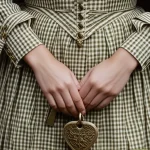Core Characteristics of Traditional British Women’s Fashion
Traditional British women’s fashion is known for its emphasis on quality fabrics and timeless design. Key features include the use of distinctive textiles such as tweed, wool, and delicate lace, all integral to British style essentials. Tweed and wool provide warmth and durability, often crafted in subtle muted tones or classic checks that reflect the country’s countryside heritage. Lace adds a feminine touch, contrasting with the structured nature of other materials.
The fashion revolves around classic silhouettes and tailoring, prioritizing elegance and refinement over trends. Well-fitted jackets, pencil skirts, and tea dresses showcase precision in cut and a proper fit, hallmarks of traditional British women’s fashion. This tailoring approach ensures garments flatter and maintain a polished appearance suitable for various occasions.
Also to read : How Does British Women’s Fashion Reflect Modern Cultural Trends?
Characteristic colors and patterns further define British style essentials. Alongside muted hues, gentle florals evoke a sense of tradition and understated grace, complementing the fabric choices. The interplay of these elements—texture, silhouette, and color—creates a cohesive style marked by both practicality and charm. This balance of classic design with heritage fabrics remains central to traditional British women’s fashion.
Iconic Garments and Typical Wardrobe Pieces
Traditional British women’s fashion is distinguished by several iconic British garments that form the backbone of a well-rounded wardrobe. Among these, tweed suits and jackets stand out as quintessential British clothing staples. Crafted from robust, textured tweed, these suits provide both warmth and a refined countryside charm, perfectly embodying British style essentials. Their structured tailoring ensures a flattering silhouette, consistent with the tradition’s emphasis on fit.
Also to discover : What are the key factors in choosing sustainable fashion brands in the UK?
Another key piece is the tea dress, celebrated for its delicate, feminine appeal. Often made from light fabrics with subtle florals, tea dresses combine comfort with elegance, illustrating traditional British women’s fashion’s balance between grace and practicality. Complementing these are tailored skirts, which afford versatility and an appointment-ready look suitable for both casual and formal settings.
Trench coats are another staple, originally designed for adaptability in British weather. Their functional yet stylish design has secured them a lasting presence in traditional wardrobes. Lastly, knitwear in refined wool hues offers both softness and insulation, reinforcing the importance of quality textiles within British fashion essentials. Together, these garments showcase the timeless and enduring nature of traditional British women’s attire.
Influential Eras in British Women’s Fashion
Historical British fashion has been deeply shaped by Victorian era fashion, Edwardian style, and the post-war period. Victorian fashion introduced structured silhouettes, with corsetry and high collars creating an elegant yet rigid form. This era emphasized modesty and craftsmanship, establishing key features like lace detailing and rich textiles that persist in traditional British women’s fashion today.
Edwardian style softened these silhouettes, favoring lighter fabrics and more relaxed fits with an emphasis on delicate embellishments, such as embroidery and subtle florals. These design choices influenced the balance between practicality and femininity still seen in British style essentials.
The post-war influence brought a pragmatic approach, focusing on functionality and simplifying shapes, which allowed women greater mobility and reflected social changes. This evolution encouraged blending classic tailoring with modern comfort, a hallmark of contemporary British womenswear.
Together, these eras provide a foundation for many traditional British clothing staples, creating a continuum of style that remains relevant. They demonstrate how historical fashion elements retain influence by adapting to modern needs while preserving timeless elegance.
Accessories and Finishing Touches
In traditional British women’s fashion, British fashion accessories play a vital role in completing the look with timeless elegance. Signature accessories such as hats and gloves have long been staples, offering both style and a nod to British cultural heritage. Hats, from structured berets to classic fascinators, add sophistication and are often chosen to complement formal attire or outdoor events, reflecting the refined nature of British style essentials.
Gloves, traditionally made from fine leather or delicate fabrics, provide a graceful finishing touch, blending functionality with decorative appeal. Scarves and brooches also enrich the ensemble, often featuring subtle patterns and classic motifs, enhancing the outfit without overwhelming it.
Handbags and footwear in British fashion accessories are crafted with an emphasis on quality and versatility. Structured handbags in muted tones harmonize with tailored garments, while classic pumps or riding boots ensure practicality alongside elegance.
Subtle, elegant jewellery is another key feature, favoring pearls or understated pieces that complement rather than compete with the overall look. These traditional accessories not only enhance the outfit but embody the balance between practicality and grace central to British clothing staples.
Notable British Brands and Designers
Traditional British women’s fashion owes much to British fashion designers and heritage brands that have shaped and sustained its elegance. Renowned British fashion houses, such as Burberry and Alexander McQueen, are celebrated for their dedication to craftsmanship and innovation within the framework of tradition. These heritage brands often integrate classic tailoring and signature textiles like tweed and wool, reinforcing British style essentials with a contemporary edge.
Iconic brands specializing in traditional womenswear, including Mulberry and Barbour, emphasize durability and style through carefully crafted pieces such as trench coats and knitwear. Their work underpins much of what is recognized as British clothing staples, confirming their role in maintaining sartorial identity.
The influence of British labels extends globally by exporting elements of refined tailoring, muted tones, and distinctive patterns characteristic of traditional British women’s fashion. Beyond commercial impact, these designers inspire ongoing reinterpretations of classic forms, ensuring the vitality of British couture in a modern context. Their contributions highlight how innovation and heritage coexist, securing the prominence of British fashion worldwide.








